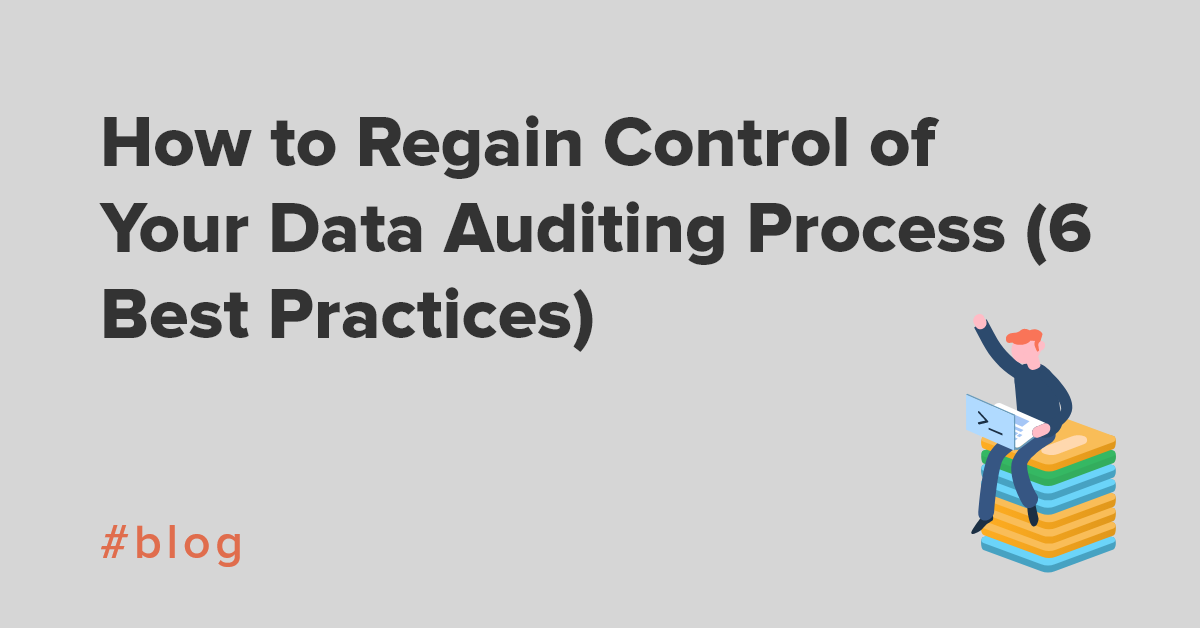Data auditing is a challenging process, particularly for organizations that suffer from siloed data, uncorrelated datasets or uncommunicative departments. But, without a well-managed data governance framework in place, you’ll fail to gather a complete overview of your organization’s efforts and avoid troublesome data problems.
What exactly is data auditing?
Data auditing is the process of inspecting data to assess how a company's data is fit for given purpose. This involves profiling the data in question and assessing the impact of poor quality data on the organization's performance and profits. Data auditing can also refer to the examination of a system to determine its efficacy in performing its function.
What’s more, without a complete data audit, you’ll miss out on some incredibly beneficial perks. A thorough data auditing process will:
- Help you comply with internal data policies, as well as wider data governance procedures
- Provide a better insight into how successful (or unsuccessful) your business processes are, helping you to discover areas for improvement or investment
- Ensure you avoid “dangerous data” you may otherwise miss outside of a rigorous audit – this means you can detect security threats, anomalies and data inefficiencies early on
But, to enjoy these benefits, you’ll first have to navigate a web of data auditing challenges.
Identifying common data auditing challenges
Unfortunately, there are a fair few challenges involved when it comes to examining all of your datasets.
These include:
- The scale of your data. With the amount of data and integrations you process growing day-by-day, you’ll need to find methods for documenting and extracting every dataset. This includes easily hidden data.
- Isolated or duplicated data. This is commonly caused by departments dealing with their data within their own ecosystem, rather than sharing it with wider organizational data efforts.
- Uncorrelated data, resulting in an unreliable overview of your data.
- Manual, outdated processes that hinder transparency.
Although these problems may seem small individually, they mount up. Ultimately, they can cause problems that’ll require additional teams and costs to remedy. And, if these challenges continue, you run the risk of going against important internal and external governance regulations.
For the sake of your data auditing process, you’ll need to rein in these problems.
Fortunately, we’ve got a thorough step-by-step process to help.
6 data auditing best practices you should be following
With the right approach, data auditing doesn’t need to be challenge. We’ve listed six best practices your organization can undertake to help rein in your auditing process.
Let’s dive in.
1. Discover your data (regularly!)
Data discovery helps you uncover all your data and understand exactly where any problems lie. This remedies problems like hidden datasets or silos and builds a complete picture of all your data processes. In turn, this reveals trends and inefficiencies (such as missing data fields).
Although it may seem like a large and daunting process, you should conduct data discoveries on a regular basis. This involves sifting through all of your organization’s data to pick out every single data set. You’ll need to do this because, as your data grows, so does the likelihood of missed opportunities and dangerous anomalies.
To help ease this burdensome process, consider using automated tools to automatically scan databases, discover data and classify whether it’s sensitive. This will help you identify data quickly, giving you the perfect foundation for your data auditing process.
2. Collaborate on a company-wide level
The volume of your data isn’t only challenge facing your data auditing process. Your people and internal processes are another potential roadblock.
Split responsibilities and lack of communication can result in inconsistent audit processes, data silos and missed analytic opportunities.
In order to remedy this problem, try to collaborate with each of your departments, distinguish a common data vocabulary and align your data auditing and management practices. Between you, define how to label your data fields, for instance, calling a field ‘customer name’ instead of ‘name’. This will help you avoid confusion and hidden datasets.
Ultimately, building collaboration will create ‘one version of the truth’, in turn preventing your teams from creating silos, and helping you to secure a successful data audit process.
3. Map your data
Now that you’ve discovered all your data and aligned your teams, it’s time to map your datasets together and begin the data integration process.
Taking the time to properly map your data helps you catalogue:
- What data you have
- Whether it’s formatted correctly
- How it’s being used
- Where it’s stored
- Who’s responsible for it
- How sensitive it is
- If there is any third-party involvement
By documenting how you handle your data throughout its lifecycle, you’ll be able to track its purpose and location at any time. If there is an issue with either of these factors, it’s a clear sign that there’s a discrepancy between your original map and your operational processes.
4. Standardize your processes
By this point, you should have an idea of how you want your data to be processed going forward.
The next step is to standardize your processes. This may be as simple as creating an internal data processing and governance document for all your teams to refer to. This document may include: individual responsibilities, data terminologies, data rules (how certain datasets should be processed) and correct data field formats.
However, if you’d like to do more and with minimal effort, it’s worth turning your data processes into actionable data models. These models document your data lineage for certain data flows, allowing you to track your data from the beginning of its journey to its end. When auditing, or compiling a record of your processing activities, these models make finding your data and the story behind its purpose much easier.
5. Translate your data models into executable code
Unfortunately, you run the risk of individual developers translating your data models incorrectly, based on their own interpretations of a model’s rules and formats.
However, there’s a simple solution that can make the data modelling process repeatable and reliable. By translating your models into runnable objects, you can repeat defined terminology and ‘rules’ with the click of a button. These building blocks are essentially code building blocks that cut out the time needed for development and narrows the potential for human error.
As your coded data models follow the same strict, untouched rules, you can be sure that any data running through them is standardized. Should you need to piece together your data trails in future, for your data auditing process or otherwise, these models will also allow you to catalogue and follow your data’s lineage from source to end point.
6: Document your practices
Keeping an ongoing Record of Processing Activities (ROPA) is necessary under the GDPR for organizations with more than 250 employees (or those which consistently process sensitive data).
As well as helping to keep your organization compliant, a ROPA makes tracking data usage, purpose and accountability much easier. With a complete overview of all of your data processing activities, across your business, you’ll be able to pinpoint how your data has been used and who has been handling it. Following the first five steps in this article, should help you piece together all the information you need to complete this document.
Make your data auditing process a breeze
We hear you - data auditing is a complex process. After all, it often requires sifting through years of data, metadata and code to understand exactly how the underlying processes work.
But, as data compliance regulations become more stringent, cutting corners and failing to gain a complete overview of your operations will only make life more difficult. The trick here is to develop a data strategy that uses data auditing to its advantage and helps increase the efficiency of your integrations.
By following the steps above, you can put together everything you need to regain control of your data processes and provide the transparency you need for regulatory reporting. All you need now is the right tool for the job.
To find out how you can turn business logic into accurate and executable code with CloverDX, check out our comprehensive guide to bridging the gap between data models and IT operations.









